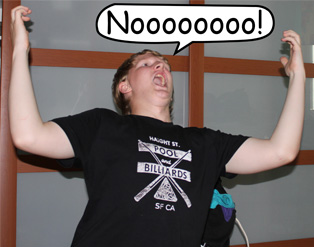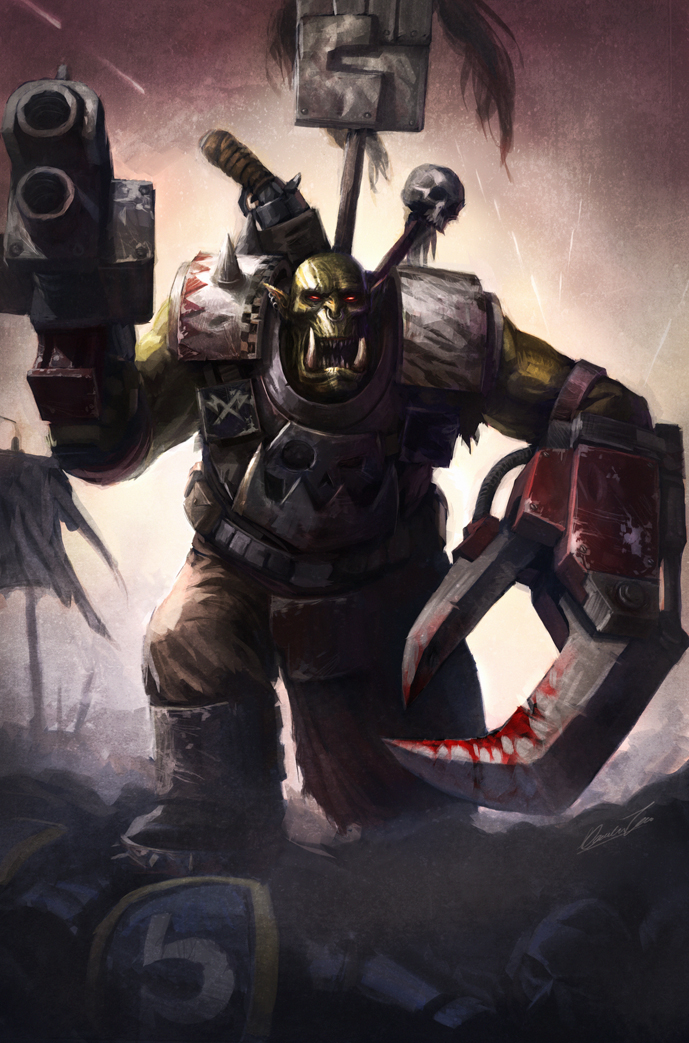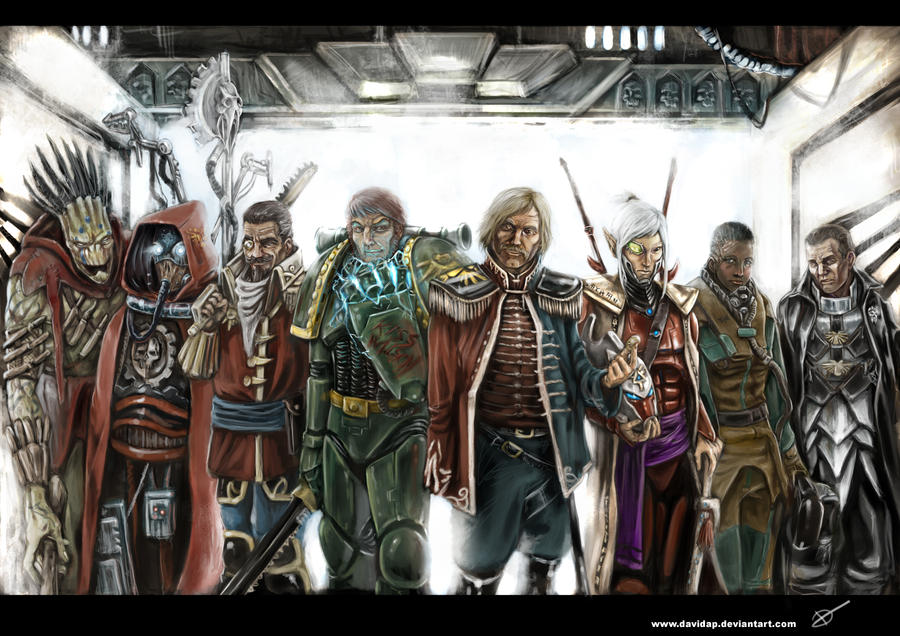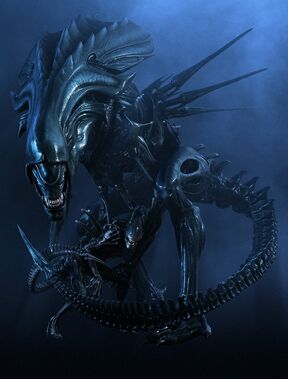 So, one reason I haven't been posting in a while was because I was getting ready for a big event - RuchtCon II! Basically, it's a gaming convention that my friends and I throw out of our own homes.
So, one reason I haven't been posting in a while was because I was getting ready for a big event - RuchtCon II! Basically, it's a gaming convention that my friends and I throw out of our own homes.Wednesday, April 6, 2011
The View from RuchtCon II - Part 1
 So, one reason I haven't been posting in a while was because I was getting ready for a big event - RuchtCon II! Basically, it's a gaming convention that my friends and I throw out of our own homes.
So, one reason I haven't been posting in a while was because I was getting ready for a big event - RuchtCon II! Basically, it's a gaming convention that my friends and I throw out of our own homes.Sunday, April 3, 2011
Friday, March 11, 2011
Seventeenth Session Part Three - The Big Battle

Sunday, February 27, 2011
Seventeenth Session Part Two - Interactive Cutscene
 Da Monsta: a hulking, 40 foot tall super-ork
Da Monsta: a hulking, 40 foot tall super-orkSunday, February 20, 2011
Cutscenes in Roleplaying Games
Way back in my college years, there were many video games that dominated our time - Warcraft, Warcraft II, Doom - the list goes on. But one game in particular sticks out in my mind - Star Wars: TIE Fighter for DOS.
- For the most part, each cutscene didn't reveal too much. In the game, "you" took on the role of a TIE Fighter pilot, so most scenes never gave you information you were not supposed to have.
- The cutscenes were short, sweet, and to the point.
- The cutscenes also were a form of reward. You got to watch a (what at the time was) a cool motion graphic.
- The scenes gave the game an epic feel, because it showed how your actions in each individual mission ultimately affected the fate of the Empire and the rest of the galaxy.
- The scenes allowed you to get to know the villains and antagonists in the story, because you certainly weren't going to meet them in space while flying a starship.
Thursday, February 17, 2011
Prepping for a Big Set Piece
Now, these pictures of the actual game (forgot my camera), but some staging to give you an idea of what it would have looked like. There are no squares on the improvised battlemat, so old-fashioned measuring tape worked just fine. Yes, you'll see some chaos raiders there. Those were stand-ins for ork fighta-bommas. Didn't have the money to spring for a squadron of real ones.
Monday, February 14, 2011
Seventeenth Session - Part 1: Journey to the Undred-Undred Teef

Thursday, February 10, 2011
Glorious Failure

Now, for most of this blog I've been crowing about my own successes here. And overall, the campaign has been a tremendous success. My players have said as much.
Tuesday, February 8, 2011
The Orks is Comin'!

Well, for the big battle, I made up a bunch of stats for ork vehicles as well. I didn't use most of them, because...well, you'll see later...but I made them up anyway.
Ork Blasta Tank

Type: Ground Vehicle Tactical Speed: 10m
Cruising Speed: 50 kph Manuoeverability: -5
Structural Integrity: 25 Size: Enormous (+20 to hit -20 to conceal)
Armour: Front 40, Side 30, Rear 20 Special: Unreliable – 20 to repair
Crew: Driver, Gunner, Crew Chief
Weapons:
Position: Gunner
Great Big Shoota (Front); Range: 300 to 700 m (1d5+2 AUs), Heavy, RoF: S/-/-; Damage: see special; Clip: ?, Reload Full; Special: Random Fire – Roll 1d5 to determine what kind of shell is fired.
1) Boom Shell 3d10+20, Pen 20
2) Tank Hamma Shell 8d10, Pen 0
3) Burna Shell - vehicle catches fire, 1d10 to structural integrity until put out
4) Scrap Shell – 3d10, Pen 0, Vehicle takes a 1d5 crit hit
5) Dud
Ork Fighta Bomma

Type: Craft Tactical Speed: 20m / 22 AUs
Cruising Speed: 1,600 kph / 5 VU Manuoeverability: -5
Structural Integrity: 25 Size: Massive (+30 to hit -30 to conceal)
Armour: Front 25, Side 25, Rear 20
Crew: Pilot, Crew Chief/Bomma, Forward Gunner, Rear Gunner
Weapons:
Position: Forward Gunner
Twin-Linked Big Shoota x1 (Front); Range: 600m (6 AUs), Heavy; RoF: S/-/-, Damage: 5d10+10 I, Pen 10; Clip: -; Reload -; Special: Twin-linked (+20 to hit, 2 shots fired)
Position: Rear Gunner
Auto Cannons x2 (Sides); Range: 300m (3 AUs), Heavy; RoF: S/2/5, Damage: 4d10+5 I, Pen 4; Clip: 60, Reload 2 Full; Special: None
Position: Bomma
Big Boms: Range: 0; RoF: -; Damage: 3d10+20 X, Pen 20; Clip: -; Reload 2 Full; Special: Blast (10)
Ork Stompa

Type: Walker Tactical Speed: 5 m
Cruising Speed: 30 kph / 1 AU Manuoeverability: -20
Structural Integrity: 65 Size: Massive (+30 to hit -30 to conceal)
Armour: Front 35, Side 35, Rear 30
Crew: 2 Drivers
Weapons:
Position: ?
Twin-Linked Big Shoota x1 (Front); Range: 600m (6 AUs), Heavy; RoF: S/-/-, Damage: 5d10+10 I, Pen 10; Clip: -; Reload -; Special: Twin-linked (+20 to hit, 2 shots fired)
Position: ?
Deth Kannon x1 (Front, Sides); Range: 600 m (6 AUs), Heavy, RoF: S/-/-; Damage: 4d10+20 E, Pen 15; Clip: 250, Reload -; Special: Inaccurate (No bonus for aiming)
Supa Skorcha x1 (Front, Sides); Range: 30 m (0 AUs), Heavy, RoF: S/-/-; Damage: Special; Clip: -, Reload 2 Full; Special: catches enemy on fire, 1d10 to structural integrity until put out
>
Saturday, February 5, 2011
Making Up Stats for the Big Fight

So I knew that I wanted to stage a really epic and momentous battle in the Undred-Undred Teef. I So, as I did with the Battle at Footfall, I started sketching out set-pieces. One of the set-pieces I started arranging was a big vehicle battle.
 Look at the cornucopia of minis Nick bought for the campaign! There are troops on bases, here, mostly. As well as some tanks (grey-colored on the right). The Reaver Titan is prominent, of course.
Look at the cornucopia of minis Nick bought for the campaign! There are troops on bases, here, mostly. As well as some tanks (grey-colored on the right). The Reaver Titan is prominent, of course.
Leman Russ Tank
Type: Ground Vehicle Tactical Speed: 10m
Cruising Speed: 50 kph Manuoeverability: -5
Structural Integrity: 35 Size: Enormous (+20 to hit -20 to conceal)
Armour: Front 40, Side 30, Rear 20 Special:
Crew: Driver, Gunner, Crew Chief
Weapons:
Position: Gunner
Twin-Linked Autocannon x1 (Front); Range: 300 m, Heavy, RoF: S/4/10; Damage: 4d10+5, Pen 4; Clip: 40, Reload: 2 Full; Special: Twin-Linked (+20 to hit)
Turrent-Mounted Lascannon x1 (Front, Sides, Back); Range: 300 m, Heavy; RoF: S/-/-; Damage: 5d10+10, Pen 10; Clip: 10; Reload: 2 Full; Special: Twin-Linked (+20 to hit, Fires 2 shots)
Reaver Titan
Type: Walker Tactical Speed: 5 m
Cruising Speed: 45 kph / 1 AU Manuoeverability: -20
Structural Integrity: 65 Size: Massive (+30 to hit -30 to conceal)
Armour: Front 40, Side 45, Rear 40 Void Shields: 40%
Crew: 1 Drivers, 1 Tech Priest, 2 Servitors
Weapons:
Position: Tech-Priest
Carapace Mounted Rocket Launcher (Front/Left/Right); Range: 75km (750 AUs), Heavy; RoF: S/4/8, Damage: 3d10+20 X, Pen 15; Clip: 24; Reload -; Special: Burst and Auto Fire
Position: Pilot
Arm Mounted Turbo Laser Battery x2 (Front); Range: 700 m (7 AUs), Heavy, RoF: S/-/-; Damage: 8d10 E, Pen 10; Clip: 1, Reload 2 Full; Special: Blast (10)
Monday, January 31, 2011
Sixteenth Session - Preparing for the Grand Battle

Friday, January 28, 2011
The Problem with Knowledge Skills

One problem I’ve always encountered in roleplaying games is the “knowledge check” dilemma. At most tables I’ve played at, if a player has a knowledge skill, they activate it by rolling the skill. If they succeed, the GM tells them aloud what they know about a particular topic. Then, the player does one of two things. They either repeat the same thing that the GM just said…which now seems redundant. Or they simply turn to the rest of the group and say, “I share this with the party.”
Either way, this results in the spotlight being moved away from the character with knowledge skills. Furthermore, this makes knowledge-based characters extremely boring to play. If you’re a wise, knowledgeable character, your speciality is to have GM to tell you stuff while you passively listen.
In most of my games, I’ve tried to combat this with the sidebar. I pull the player aside, tell them what their character knows, then let them go back to the table and relate it to the group. This has worked brilliantly in the past. Often, when the player retells the information, they will put their own spin on it, making the information slightly colored or biased – which it should be. Also, it enhances roleplay, since the players can talk about the new information in character.
However, with a big group, this has proved detrimental. Constantly pulling players aside with a big group pauses the action, and with a group as large as ours, it often caused more distractions.
So, what to do? I ended up robbing an idea from myself.
Cards with Information

For really big, earth-shattering revelations, I can even dress up the information cards with a picture or something like that. This really calls attention to the information and gives the player something visual to latch onto.
Tuesday, January 25, 2011
Staging a Battle...And Keeping the Horror

Maintaining tension and horror during a fight can be difficult. Often times, if the player characters are facing some unnamed horror from beyond, the tension and suspense can be high. But the moment you break out the dice and rolling to hit, it dissolves the horror.
In my opinion, there are a number of ways to handle this.
Not Just a Straight Up Fight
If you think about a movie in which a fight breaks out without losing that sense of horror, how do they do it? Often times, movies will feature a battle with the film's nemesis which is not up-front and in your face, but instead a conflict full of mystery and surprises.
Running From Something
Sometimes, a fight need not be a "we're going to kill you or you're going to kill us" event. The reason that this can be detrimental to horror is that in most RPGs, there is an unspoken expectation that the PCs will win the conflict. Most players want there to be a chance to fail in any conflict, but they usually want that chance to be small. When it looks like the PCs are going to lose, typically what you see around the table is frustration. Or disheartenment.














